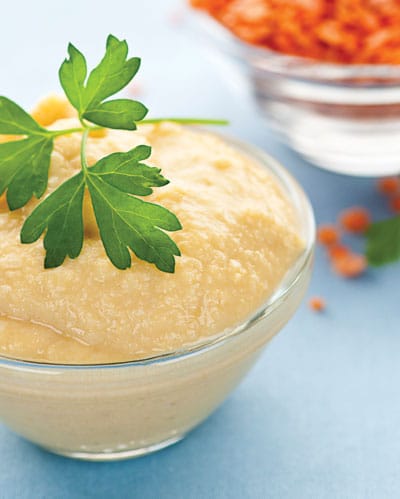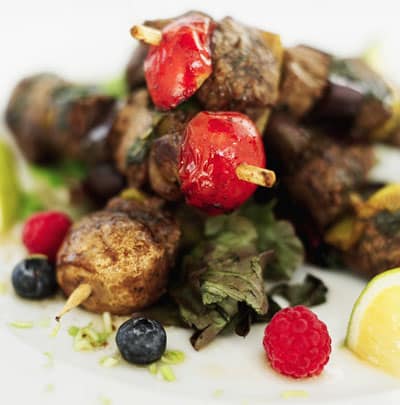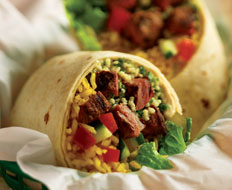Falafel, hummus, and pitas aren’t your typical American restaurant favorites.
Increasingly, however, these items are making their way onto the nation’s menuboards as part of the growing popularity of food rooted in the eastern and southern Mediterranean. And, not surprisingly, more quick-service and fast-casual restaurants are serving them.
“Americans have been looking for spicier, bolder, more flavorful offerings, and we are seeing that in food of the eastern and southern Mediterranean,” says Darren Tristano, executive vice president at Technomic, the Chicago-based restaurant consultancy.
Nearly as important from a limited-service standpoint, dishes from the Levant—eastern Mediterranean—and North Africa are typically portable and often healthy.
Quick-service Mediterranean brands are popping up across the country, featuring such favorites as shawarma, tabouleh, and baba ghanoush. They may not be the next spaghetti and meatballs, burritos, or lo mein, but they are catching on.
“These type of dishes have very bold flavors, and there is a niche for them,” says Leo Timatyos, founder of nascent ChickPita Fresh Mediterranean Grill, which has four units in Southern California and one in Chicago. “I felt a quick-serve concept could fill the niche.”
Alon Mor thought the same, and that led him to launch Garbanzo Mediterranean Grill in Denver in 2008, the year that ChickPita also launched. The Colorado operation has 13 units and is expected to expand outside the state this year.
“I saw what the Asian fast-casual food segment did and the Mexican food segment, and there was no reason we couldn’t do the same,” says Mor, whose restaurant chain features Mediterranean and Middle Eastern foods that are popular in his native Israel.
Many menu items and flavors at these new eateries have been popular for centuries in countries from Turkey to Morocco. But most Americans in the past have considered Mediterranean to be pasta, sauces, and other cuisine from Italy, southern France, Spain, and Greece.
“There is a broader, richer Mediterranean than many people have generally considered,” says Bill Briwa, chef instructor at the Culinary Institute of America at Greystone in St. Helena, California. “These foods have migrated all around the region.”
In fact, the Mediterranean “is a huge melting pot,” says Bill Post, CEO of Roti Mediterranean Grill, which began in 2007 and has seven units in the Chicago and Washington, D.C. areas. “There are all types of flavors and spices that we use.”
Food from countries around the Mediterranean Sea got an extra push in the 1990s with the heart-healthy Mediterranean Diet. The base of the pyramid-shaped plan consists of olive oil, fruits, vegetables, nuts, legumes, herbs, spices, and whole grains.
These ingredients are prominent in the menus at many quick-service restaurants that feature dishes from the eastern and southern Mediterranean.
“In some cases, the ingredients and flavors may not be familiar to some Americans, but consumers are looking for spicier, bolder, and more flavorful offerings,” Tristano says. “Not only that, but they have healthfulness, with olive oils, salads, and hummus.”
Garbanzo’s Mor says it is important to be authentic. “I get a container of products every month from Israel” to make sure customers get the “real thing,” he says.
Healthfulness and freshness are central to many Mediterranean restaurants—not necessarily the diet that carries the region’s name. But Garbanzo this year developed an initiative that combines healthy eating tips and social media support.

The program emphasizes the benefits of the Mediterranean Diet and encourages Garbanzo’s social media followers to post and share their healthy-eating stories on the chain’s Facebook page.
Although most Mediterranean restaurants in the U.S. feature many nutritious menu items from the base of the Mediterranean Diet’s pyramid, their menus also contain plenty of dishes with meat, which sits atop the triangle, meaning it should be eaten in smaller amounts.
Lamb, beef, and chicken are prepared as shawarma, a term derived from the Turkish word for turning. Pork is not used because of the region’s historic religious practices.
Slices of spiced meat are placed on a stick, cooked over a flame or broiler, and then sliced vertically. It is typically served as a sandwich using a pita or flatbread.
Different spices and toppings for shawarma depend on the styles of various countries, “which all prepare it their own way,” Timatyos says.
[pagebreak]
Shawarma is among the street foods of the eastern and southern Mediterranean that are typical of less-complicated menu items served at U.S. quick-service and fast-casual restaurants. Like much of the food from that region, it is rooted in history and inspired by culture.
“The food is tied together because the countries from Turkey to North Africa have a nomadic background, which makes for simpler food,” Briwa says. “You don’t hop on a camel and race across the desert and then set up a kitchen. Simplicity is important.”
Lamb, goat, and chicken became the meat of choice for those people who didn’t have access to pasture land. For nomads, “the easiest way to move food was to let it walk in front of them,” the chef says. The meat was then roasted on a stick or spit.
Similarly, flatbread and pitas became logical choices for those who lived in harsh environments where fuel and ovens were not available. It was easy to mix up a quick dough and cook it on a griddle or stone or bury it in the sand covered by a fire.
Most shawarma sandwiches or wraps at limited-service restaurants cost $5–$6, while platters with sides are a couple dollars more. The sides range from about $2 to $3 each.
Chicken seems the favorite dish at most Mediterranean concepts, although the falafel sandwich has become “wildly popular” at Roti, Post says.
Falafel refers to deep fried balls or patties of chickpeas or fava beans, often served in a pita or flatbread with vegetables and toppings, such as a sesame seed paste called tahini. The dish is believed to have originated in Egypt and is found across the Levant.
At Maoz Vegetarian, falafel is available in a pita sandwich, a salad, or as a side item. Several toppings, eight sauces, and a salad bar help fill the pita pockets. The combo deals include choices of Mediterranean favorites, such as hummus and baba ghanoush.
“Our menu is very simple,” says Aviv Schwietzer, director of operators for the 13 U.S. units of Maoz, which began in The Netherlands in 1991. “All of our food, each and every salad, is made fresh every morning.”
The chain’s falafel is made with chickpeas, also known as garbanzo beans, which are soaked every night and then ground with parsley, cilantro, and various spices.
“We buy the spice seeds and grind them ourselves,” he says. “We package it and send it to our units” in the New York–Washington corridor; Boca Raton, Florida; and Berkeley, California.
The importance of chickpeas to Mediterranean food can be found in the names of some of its restaurants, including ChickPita Fresh and Garbanzo Mediterranean Grill.
In addition to falafel, hummus is also made with the legume.
Hummus may be the fastest-growing Mediterranean food in the U.S. It is made with cooked and mashed chickpeas, which are typically blended with olive oil, lemon juice, garlic, and tahini or other spices.
When Roti began in 2007, Post says, “we’d go to Whole Foods and there was one brand name of hummus and three flavors. Now, you’ll find three brands and 23 flavors.”
Many grocers now carry packaged hummus, baba ghanoush, tabouleh, pitas, and other items from the Levant and North Africa.
“This stuff is all becoming mainstream. And it’s healthy and part of a whole change going on in the American diet,” Post says.

Even some more general fast-casual chains feature hummus, including the Birmingham, Alabama–based Zoe’s Kitchen, which has 45 units in 12 Southern and Southwestern states.
ChickPita, based in Los Angeles, offers six types of hummus, including a traditional recipe, but also varieties such as avocado, “because this is California, after all,” says Timatyos, who previously lived in Chicago and whose father is Lebanese.
Garbanzo serves one type of hummus but is looking to add flavored varieties.
“Hummus today may be the next guacamole,” Mor says. “Once it became popular, you began to have some chefs playing with it, seeing what they can do.”
The spices used in the foods of the eastern and southern Mediterranean are not as hot as those from India and other countries to the east, but they are still very flavorful, Technomic’s Tristano says. Increasingly, they are becoming common in America.
“Some of the more popular restaurants may move slowly” to incorporate some unusual spices, he says. “There is an opportunity for spicier and bolder flavors, but they also want to make it appeal to a wider audience.”
Still, it’s not like former efforts to homogenize ethnic foods.
[pagebreak]
“For a long time, America was the melting pot where people brought culture and food and it was watered down to appeal to more people,” Briwa says.
“Now we’re seeing an America that is a salad bowl, where we honor and keep authentic cultural items in tact.”
In addition to black pepper, popular spices from the Levant and North Africa include cumin, coriander, chili pepper, mint, paprika, turmeric, and allspice.
At Roti, the spices are often those that have “become more mainstream in the American profile,” Post says. The chain’s spicing profile is not necessarily identical to those in Lebanon or other Mediterranean countries, but it retains the basic flavor.
One of the reasons for the wide array of spices in Mediterranean food is because many of the nations in the region were along ancient spice caravan routes, several of which ended in Morocco.
As a result, Moroccan food “puts a polish” on the use of spices in Mediterranean dishes, Briwa says. “They’ve become experts at it.”
Diners can find a variety of spices in the menu items at Tangerine Café, a busy quick-service unit at Disney World’s Epcot Center.
“We use all kinds of fresh ingredients and spices—that’s Moroccan food,” says Samab Benzari, the executive chef.
“We do menu items from all across the Mediterranean, like falafel and hummus. Our shawarma uses a mix of spices, including ginger, cumin seeds, coriander seeds, salt, cloves, nutmeg, cinnamon, and black pepper,” similar to a rub.
Meals range from about $9 to $14.
Most Mediterranean restaurants also feature tabouleh, a salad that mixes bulgur (a whole grain) with chopped parsley, mint, tomato, onion, lemon juice, and olive oil. Lebanese tabouleh often uses more parsley than bulgur.
Another popular salad is baba ghanoush, which is mashed or cut eggplants mixed with herbs and seasonings that may include tahini, salt, mint, cumin, chili powder, parsley, garlic, and lemon juice.
With all these options, part of the challenge for limited-service restaurants is to make the menu as streamlined and efficient as possible. At Roti, for instance, leaders have spent the past year refining and simplifying its offerings.
“We want to be the type of concept that recognizes what our customers want,” Post says. “That allows us to enter a growing stage able to cater to a mass customer base.”











